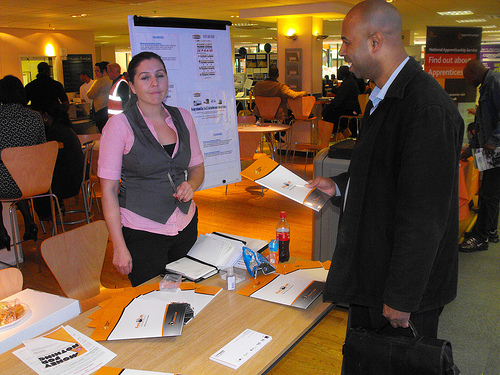Posted on 04 April 2011. Tags: department of labor, economic crisis, economist, fraction, jobless rate, nonfarm payroll, recession, unemployment rate, wall street, wall street investors
 Employment rate in the United States grew steadily for the second straight month in March, as the unemployment rate dropped at 8.8 percent. The shift in trends in the labor market is likely to help the United States recover from economic crisis in the past few years.
Employment rate in the United States grew steadily for the second straight month in March, as the unemployment rate dropped at 8.8 percent. The shift in trends in the labor market is likely to help the United States recover from economic crisis in the past few years.
The Department of Labor said Friday that the nonfarm payroll has increased by 216,000 last month. The gain was pre-empted by 194,000 new positions that opened February 2011.
As a result of the very favorable pace of job growth lately, the unemployment rate has been pulled down ever since November 2011. Reports said that the decrease from November to March is the greatest decline since 1984.
An independent result also indicated that there is an elevation in factory activity March this year. This means there would be more jobs in the industrial area in the United States.
However, economist Julia Coronado said that although these reports tell us that our economy is slowly regaining strength, it also means that the United States has a very long way to go in terms of employment.
The U.S. economy is clearly gaining momentum but it has only recovered a small fraction of what it has lost during the recession. There are said to be 8 million jobs lost when a recession hit the U.S.
Many Wall Street investors are more than pleased with the reports. They also cheered the modest augment to the U.S government bond and the strengthening U.S. dollar exchange rate against the Japanese yen.
Posted in Business
Posted on 26 January 2011. Tags: barometer, different kinds, edelman, gdp, harrington, possibilities, public relations firm, rebound, tiny piece, unemployment rate
 The trust of Americans in different kinds of institutions fell last year as the relentlessly high unemployment rate weakened the confidence of people in government and business, a recently released study discovered.
The trust of Americans in different kinds of institutions fell last year as the relentlessly high unemployment rate weakened the confidence of people in government and business, a recently released study discovered.
The drop in United States’ trust in business occurred amidst an overall worldwide increase. The global increase is driven by the swelling confidence in fast developing economies that includes Brazil and India, the Edelman Trust Barometer revealed.
The study found that only 46 percent of Americans said they trusted business. That is 8 percent down from 54 percent the previous year.
The study was released on Tuesday. It was performed by Edelman U.S., a public relations firm. According to Matthew Harrington, the chief executive of Edelman U.S., the rebound last year was a tiny piece of euphoria. He said this year shows more of the reality that it is going to be a long toil.
Some 56 percent of the respondents worldwide said they trusted business, which is up from 54 percent last year. Respondents in Brazil, India and France influenced the general increase in confidence.
In Brazil alone, 81 percent of the total respondents said they trusted business. The figures increased from 62 percent in 2009.
Harrington said the results show an evident sense of optimism. It tells the fact that their economies are doing well, and that both home-grown and business from abroad are investing in their countries.
Brazil’s economy bloomed back in 2010 after it has shortly declined in 2009 because of the recession. They have grown an estimated 7.4 percent rate.
In comparison, the economy in United States is still struggling with the high unemployment rate. It has remained above 9 percent for the past 20 months. Certain analysts look for possibilities that GDP will grow around 2.5 percent this year.
Posted in Business
Posted on 14 January 2011. Tags: borrowers, foreclosures, housing market, purchase mortgage, treasury bonds, treasury yields, unemployment rate, year fixed mortgage, year mortgage, year treasury note
 Rates on fixed mortgages dropped for the second straight week at the same time Treasury yields are falling.
Rates on fixed mortgages dropped for the second straight week at the same time Treasury yields are falling.
The average rate on the 30-year mortgage sank to 4.71 percent this week from 4.77 percent the preceding week, Freddie Mac said on Thursday. In November, it had reached its lowest rate of 4.17 percent in 40 years.
The 15-year loan average rate dropped to 4.08 percent from 4.13 percent. It hit also hit 3.57 percent in November, the lowest rate it has ever recorded since 1991.
After the December employment report showed weaker than expected, Treasury yields dropped which moved investors to buy safer Treasury bonds. This increased its prices and lowered the yields. The 10-year Treasury note shows mortgage rates tend to trail behind the yields.
After the 40-year low in November, rates have been rising. However, investors moved their money out of Treasury and into stocks as they anticipated faster economic growth and higher inflation. Yields are apt to increase along with inflation fears.
The latest drop in rates have convinced some borrowers to refinance, but upcoming buyers remain cautious. On Wednesday, the Mortgage Bankers Association said that the number of homeowners looking to refinance increased last week. Yet, the number of people applying for a purchase mortgage fell a week ago.
Higher rates are just another obstacle that struggling housing market face. High unemployment rate, increasing foreclosures, and falling home prices are the other factors that are slowing down the market’s recovery.
Posted in Finance
Posted on 07 January 2011. Tags: central bank chief, chief strategist, consumer spending, fact that people, federal reserve, government bonds, labor department, private institutions, senate budget committee, unemployment rate
 The number of workers hired in the last month of the 2010 was notably lesser than expected amid the surprising fall in the unemployment rate to its lowest record for nearly two years.
The number of workers hired in the last month of the 2010 was notably lesser than expected amid the surprising fall in the unemployment rate to its lowest record for nearly two years.
The decline in the jobless rate was due to the fact that people are giving up their search for work. The unappealing jobs growth figure was reported by the Labor Department on Friday.
These figures suggest that the Federal Reserve will likely stay the course, along with its efforts to support the biggest economy in the world by purchasing $600 billion government bonds.
A survey done by the Labor Department among non-farm employers showed that payrolls increased 103,000 last month, which is below the economists’ expectation of 175,000. Also, hiring from private institutions rose 113,000, but government employment declined to 10,000.
These results suggest the idea that the economy is in for a long and slow jobless recovery. Brian Dolan, the chief strategist at Forex.com said that Fed cannot just surrender, not unless the unemployment rate is below 9 percent.
On the brighter side, the overall employment for the months of October and November was modified to reveal 70,000 more job gains than what was previously reported.
Even though the labor market shows signs of slow recovery, the larger economy, on the other hand, shows signs of strengthening, particularly on consumer spending and manufacturing improving. The central bank chief said to the Senate Budget Committee that they have seen an increased evidence of self-sustaining recovery in consumer and business spending.
Posted in Business
Posted on 27 September 2010. Tags: afghanistan war, anxiety disorder, head injury, post traumatic stress, post traumatic stress disorder, program director, state of virginia, suicides, unemployment rate, vietnam veterans
 A report made by the Virginia tech shows that there are about two thirds of the U.S veterans from the Iraq and Afghan wars based in the state of Virginia that is now suffering from some form of depression.
A report made by the Virginia tech shows that there are about two thirds of the U.S veterans from the Iraq and Afghan wars based in the state of Virginia that is now suffering from some form of depression.
Apart from that, there is more than one in four veterans that have suffered from a service-related head injury.
In fact, Mary Beth Dunkenberger says that the real numbers may be much higher. Dunkenberger, the author of the report, is the senior program director at the Institute for Policy and Governance at Virginia Tech.
According to her, several veterans from the Iraq and Afghanistan war were scared to confess that they are suffering from post-traumatic stress disorder or PTSD, an anxiety disorder they had developed during the war.
During demobilization, veterans are all excited to see their families, and once they admit they have PTSD, that would keep them away from their families and could harm their careers.
As part of the report that was gathered for the Virginia Wounded Warrior Program, it was discovered that 66 percent of the Virginia veterans was reported to have been suffering from some type of depression. This percentage is only second to the Vietnam veterans.
In addition, ten percent of that was reported to have high-level of depression. Also, high number of suicides has been cited among the U.S veterans.
One of the primary concerns by the U.S veterans of these two wars is their lack of access to medical treatment and facilities, particularly in very far-flung areas. They also expressed fear of losing their jobs, since U.S unemployment rate is nearing ten percent.
Posted in Health
 Employment rate in the United States grew steadily for the second straight month in March, as the unemployment rate dropped at 8.8 percent. The shift in trends in the labor market is likely to help the United States recover from economic crisis in the past few years.
Employment rate in the United States grew steadily for the second straight month in March, as the unemployment rate dropped at 8.8 percent. The shift in trends in the labor market is likely to help the United States recover from economic crisis in the past few years.
 The trust of Americans in different kinds of institutions fell last year as the relentlessly high unemployment rate weakened the confidence of people in government and business, a recently released study discovered.
The trust of Americans in different kinds of institutions fell last year as the relentlessly high unemployment rate weakened the confidence of people in government and business, a recently released study discovered. Rates on fixed mortgages dropped for the second straight week at the same time Treasury yields are falling.
Rates on fixed mortgages dropped for the second straight week at the same time Treasury yields are falling. The number of workers hired in the last month of the 2010 was notably lesser than expected amid the surprising fall in the unemployment rate to its lowest record for nearly two years.
The number of workers hired in the last month of the 2010 was notably lesser than expected amid the surprising fall in the unemployment rate to its lowest record for nearly two years. A report made by the Virginia tech shows that there are about two thirds of the U.S veterans from the Iraq and Afghan wars based in the state of Virginia that is now suffering from some form of depression.
A report made by the Virginia tech shows that there are about two thirds of the U.S veterans from the Iraq and Afghan wars based in the state of Virginia that is now suffering from some form of depression.